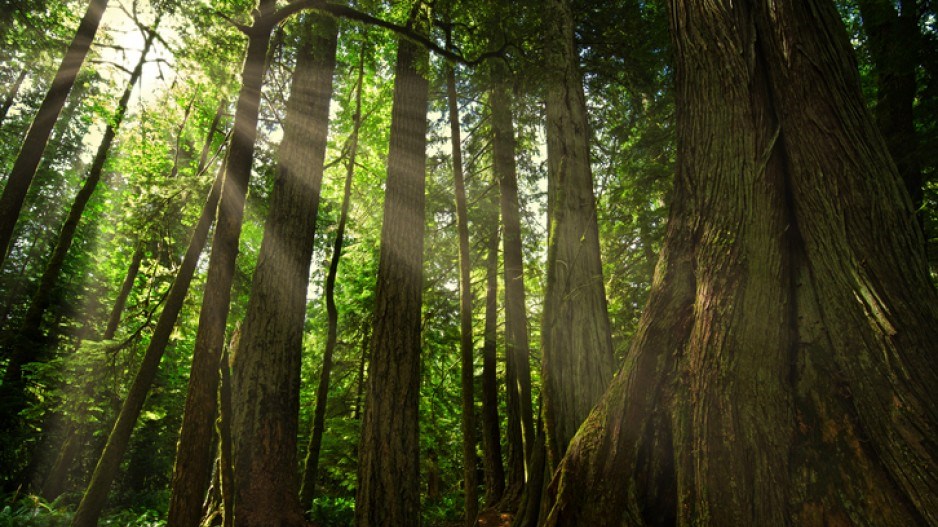British Columbians who make their living from forestry appear to be bracing themselves for some bad news any day now from the provincial government.
Some industry insiders say they expect the B.C. government to make an announcement next week – perhaps as early as Monday -- on old growth logging, and they fear the announcement will include increased “deferrals” on working forests containing old growth.
Any further deferrals to logging in areas with old growth could have significant impacts on coastal communities, like Port McNeill on Vancouver Island, depending on how extensive the deferrals are.
“I’m concerned because deferrals don’t often get undeferred,” said Gaby Wickstrom, mayor of Port McNeill, where many residents and businesses depend on logging for their livelihoods.
She said a strike by Western Forest Products (TSX:WEF) workers last year underscored just how reliant coastal communities like Port McNeill are on logging.
“The strike last year showed us what a major deferral or moratorium on old growth would do to our community,” she said. “It was pretty devastating, and it trickled through everywhere. There isn’t a store that isn’t impacted, a business that isn’t impacted, if a major chunk of the labour force leaves.”
The B.C. government has already approved two-year deferrals on logging in two areas of Vancouver Island– the Fairy Creek watershed (1,199 hectares in size, including 884 hectares of old forest) and the central Walbran west of Lake Cowichan, (1,489 hectares, 1,150 hectares of which is old growth.)
That was in addition to 200,000 hectares of old growth previously deferred, as per the Old Growth Strategic Review.
In recent days, the industry has been sending signals that it fears the B.C. government may capitulate to pressure from environmentalists to increase the amount of old growth that would be off limits to logging.
Old growth makes up 27% of B.C.’s annual allowable cut (AAC), and 50% of the coastal AAC, so coastal communities are particularly vulnerable to any increased deferrals.
Jim Girvan, an independent forestry consultant, says there simply isn’t enough second growth to sustain the current coastal industry, so if significant amounts of old growth are deleted from the harvesting base, it would mean some sawmills would have to shut down, and possibly some pulp and paper mills as well.
Earlier this week, 275 business and labour leaders signed an open letter calling on the BC government for “a fact-based, inclusive and balanced approach” to the question of logging forests with old growth trees.
“We support nearly 10,000 local businesses – businesses that sell equipment and high-tech tools, who provide environmental, silviculture and contracted services,” the letter states. “We eat in your restaurants, we volunteer in your communities and we contribute to the social fabric of our province in so many ways.
“With 75 percent of old growth forests already protected or outside the area where harvesting is allowed, we believe we can ensure old growth is preserved for future generations while also providing opportunities to families and communities who depend on a small portion of BC’s old growth for their livelihoods. We can’t do this without a fact-based, inclusive and balanced approach.”
David Elstone, managing director of Spar Tree Group forestry adviser and former BC Truck Loggers Association executive director, sent out an opinion piece to his subscribers this week that suggests the B.C. government may be getting some one-sided advice.
Earlier this year, three researchers – later appointed to the B.C. government’s Old Growth Technical Advisory Panel – produced a study, BC’s Old Growth Forest: A Last Stand for Biodiversity, that estimated productive old growth forests capable of producing the giants that most people typically associate as old growth trees to be just 3% in B.C.
More recently, Forsite Consultants produced a report, commissioned by the Council of Forest Industries (COFI), that estimated the area of productive old growth is 30%.
The two studies used different modelling approaches to arrive at their estimates.
Leonard Krog, former NDP MLA and now mayor of Nanaimo, said the debate over old growth and logging on Vancouver Island is filled with "rhetoric that doesn't relate to the facts."
"The word is bandied about that only 3% of old growth forests remain, and I think it's pretty clear that that is simply untrue," Krog said. "But that is the basis of belief and dogma for many British Columbians who aren't paying close attention to this issue.
"As the mayor of a town that still has a significant interest in forestry -- with Harmac and Coastland Mills -- it's very concerning that rhetoric and politics might win over good science and the needs of my community."
In his piece to subscribers, Elstone worries out loud that Forests Minister Katrine Conroy will only consider the estimates produced by the researchers who now sit on the government’s Old Growth Technical Advisory Panel and not the more recent Forsite report.
“Minister Conroy should provide a public statement on this new Forsite estimate on the status of old growth forests, including the amount of old growth forests with large trees, well ahead of any further deferral announcements,” he said. “If the minister has alternative estimates, we deserve to know.”
The Ministry of Forests, Lands and Resources would not confirm speculation by industry insiders that an announcement on old growth is coming next week.




